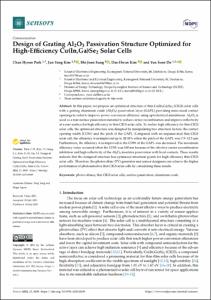Design of grating Al2O3 passivation structure optimized for high-efficiency Cu(In,Ga)Se2 solar cells
- Title
- Design of grating Al2O3 passivation structure optimized for high-efficiency Cu(In,Ga)Se2 solar cells
- Author(s)
- Park, Chan Hyeon ; Kim, Jun Yong ; Sung, Shi-Joon ; Kim, Dae-Hwan ; Do, Yun Seon
- DGIST Authors
- Park, Chan Hyeon ; Kim, Jun Yong ; Sung, Shi-Joon ; Kim, Dae-Hwan ; Do, Yun Seon
- Issued Date
- 2021-07
- Type
- Article
- Author Keywords
- Aluminum oxide ; Photovoltaics ; Surface passivation ; Thin CIGS solar cells
- Keywords
- Alumina ; Aluminum oxide ; Charge carriers ; Conversion efficiency ; Copper compounds ; Efficiency ; Nanostructured materials ; Passivation ; Reflection ; Carrier recombination ; High reflectivity ; Maximum Efficiency ; Optimized structures ; Passivation structure ; Power conversion efficiencies ; Structural factor ; Surface passivation ; Solar cells
- ISSN
- 1424-8220
- Abstract
- In this paper, we propose an optimized structure of thin Cu(In,Ga)Se2 (CIGS) solar cells with a grating aluminum oxide (Al2 O3) passivation layer (GAPL) providing nano-sized contact openings in order to improve power conversion efficiency using optoelectrical simulations. Al2 O3 is used as a rear surface passivation material to reduce carrier recombination and improve reflectivity at a rear surface for high efficiency in thin CIGS solar cells. To realize high efficiency for thin CIGS solar cells, the optimized structure was designed by manipulating two structural factors: the contact opening width (COW) and the pitch of the GAPL. Compared with an unpassivated thin CIGS solar cell, the efficiency was improved up to 20.38% when the pitch of the GAPL was 7.5–12.5 µm. Furthermore, the efficiency was improved as the COW of the GAPL was decreased. The maximum efficiency value occurred when the COW was 100 nm because of the effective carrier recombination inhibition and high reflectivity of the Al2 O3 insulator passivation with local contacts. These results indicate that the designed structure has optimized structural points for high-efficiency thin CIGS solar cells. Therefore, the photovoltaic (PV) generator and sensor designers can achieve the higher performance of photosensitive thin CIGS solar cells by considering these results. © 2021 by the authors. Licensee MDPI, Basel, Switzerland.
- Publisher
- MDPI AG
- Related Researcher
-
-
Sung, Shi-Joon 에너지환경연구부
- Research Interests Compound Semiconductor Materials & Processes
-
- Files in This Item:
-
 기타 데이터 / 2.66 MB / Adobe PDF
download
기타 데이터 / 2.66 MB / Adobe PDF
download
- Appears in Collections:
- Division of Energy Technology 1. Journal Articles



